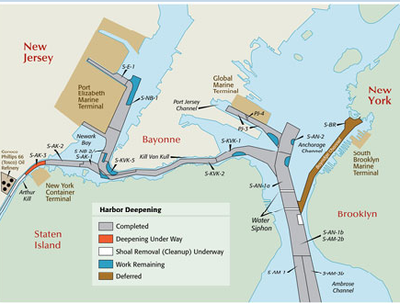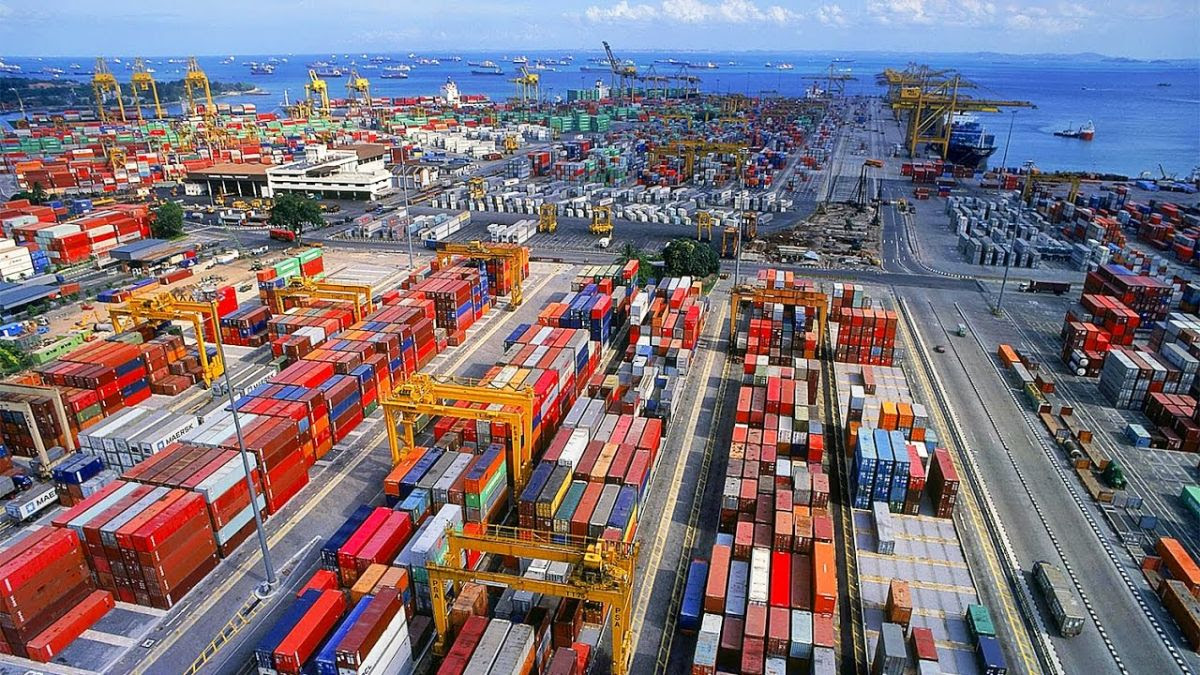Friday, January 15, 2021 – THE SHIPPING WORLD CHANGED AND THE CONTAINERS TOOK OVER


FRIDAY, JANUARY 15, 2021
The
263rd Edition
From Our Archives
PORTS, CONTAINERS & US
Stephen Blank

The busy Hudson River, 1920 GGA
Ports, containers and us
I wrote the other day about the story of the Port of New York, and it brought up to recent time. I promise to do a piece on tugboats soon, but for now let’s look at today’s port.
Quick recap: In the 1850s, as steam replaced sails and ocean going ships grew greatly in size, New York’s port shifted from the East Side of Manhattan (South Street Sea Port) to Manhattan’s West Side. We recall classic images of lines famous cruise ships moored at West Side piers and crowds of longshoremen streaming into the open hatches of steamers, hauling out bales, barrels and boxes. But things changed and, by the 1970s, patterns of travel were transformed by new, faster and more comfortable airplanes and many cruise ships were taken out of service on one hand and the way we moved goods changed dramatically. No longer were most goods packed into the bellies of cargo ships. Instead they were placed in new containers stacked on decks and in the holds of special made container ships.
So, finally, Manhattan’s ports closed down. In the future, a new cruise industry would emerge and New York would regain some of that traffic. But cargo activities increasingly relocated to New Jersey and, in particular, to Port Elizabeth. In the map below, you can see where Port Elizabeth is located.
We can also see that the way isn’t easy. Steam up the Ambrose Channel and the Narrows, then quick hard turn to port into the narrow Kill Van Kull, tuck under the (newly raised) Bayonne Bridge and then hard turn to starboard into Port Elizabeth.

One more prelim: Let’s look at containers. Packing goods in some sort of container goes back a way, but we date the birth of the modern maritime era from 1956 when the McLean Trucking Company experimented with using standardized cargo containers that were stacked and then unloaded to a compatible truck chassis. The key is standardized containers that can be neatly piled up on what soon became a purpose made container ship. To make this work, containers must be the same size, height, length and width.
New York led the way: On August 15, 1962, the Port Authority opened the world’s first container port, Elizabeth-Port Authority Marine Terminal and Elizabeth became known as America’s Container Capital.
Bear in mind that while the share of world trade in containers has soared over the past few decades, liquid carriers (mainly petroleum) and bulk carriers (iron ore, grains) are responsible for a much greater share of trade volume – though value would be considerably less. And many autos are now carried in purpose built “Ro-Ro” automobile ships (“roll on, roll off”). (For those interested, the part of the Port of New York and New Jersey with the highest value of international trade is, of course, JFK. Not much volume but a lot of value.)
There’s more to this. International standardized containers are 20ft or 40ft long and 8ft wide. Domestic containers are longer and wider – 48ft and 53ft long and 8.5ft wide. Also, containers are owned and have to get back to their owners. What this means is that much of what comes in packed in millions of international containers has to be repacked in domestic containers that are hauled to destination by train and truck. Then, hopefully, international containers are returned and reused. Complicated? You bet.
How many containers on a late model ship? Many: The largest container ships now carry more than 13,000 40 foot containers (Note – the common enumeration is by TEU, or “twenty foot equivalents”. So these ships would be classified as 26,000 TEU. Don’t ask why.). Ship builders now have designs for vessels of 30,000 TEUs or even more. Also, these new ships are fast, and their business depends on getting to destination ports quickly and on time and unloading and reloading quickly. And these giants and the huge volumes of containers require equally enormous cranes and other infrastructure (including widening the Panama Canal) on the land side.

MSC GULSUN – New world’s largest containership
Where all of this takes place is really important because space is always critical. Many ports now push the unloading of international containers away from the port itself, to larger transshipment facilities where all of this can be carried out more efficiently.
So back to Port Elizabeth. It is the third or second largest container more in North America (the first two have been Los Angeles and Long Beach, Savannah is next). But it is scarcely one of the world’s top ports; by global standards, it’s far down in league tables. As one might expect, the greatest container ports are in East and Southeast Asia. The largest by far is Shanghai with 42 million TEUs processed a year, Singapore is next with 36 million. New York is 23rd, with 7.5 million TEUs annually. Asian (including India) ports account for close to 80% of the TEUs handled by the top 50 container ports. By comparison, European and North American ports represented 12.7 percent and 6.4 percent of the total, respectively.

In 2019, 3.8 million TEUs were imported into Port Elizabeth and 3.7 million TEUs exported. But the exported containers tell an interesting story. Of these, 1.46 million were loaded and 2.2 million shipped out empty. (You might note that one of our leading exports is air, in the empty containers.) Why ship empty containers? Because they have to get back to their home bases where they can be used again.
Port Elizabeth is unusual among major ports because most of the materials imported there remain within the New York region while for other major ports – Los Angeles, Long Beach for example – the very large majority of containers are transshipped to staging areas and across the country.
There are lots of other issues – the owners and operators of ports, the owners of ships and the alliances among them. Crane manufactures and companies that transport them. And the vast world of local, national and international regulations that shape this whole enormous industry.
But let’s look at Port Elizabeth one last time. Certainly the Port has done well in the past decades. Most important, with dredging ships channels and lifting the Bayonne Bridge, it can receive the largest container ships. For the future, the need to maintain channel depth and the inherent difficulty of passage through the Kill Van Kull will be a hard slog as ships continue to grow. The size of the Port is inherently limited and access on the land side is always problematic and sometimes very difficult. Ports tend to degrade air quality, but Port Elizabeth’s location – backed by refineries and Newark Airport – make this less of a port problem.
The New York Shipping Association recently found that the port industry of New York and New Jersey accounted for nearly $12 billion in tax revenue, supported over 500,000 jobs, and was responsible for $36.1 billion in personal and $99.5 billion in business income in the region in 2019.
And no one knows the future of international trade. A short while ago, we focused on the emergence of global supply chains and the ascending importance of international movement of parts and components along these routes, increasingly moved by larger and larger container ships. Today? Who knows.
Thanks,
Stephen Blank
RIHS
January 14, 2021
FRIDAY PHOTOS OF THE DAY
SEND YOUR SUBMISSION TO:
ROOSEVELTISLANDHISTORY@GMAIL.COM

THURSDAY PHOTO OF THE DAY
Members of the RI Garden Club
Alexis Villefane got it right!
Question: How many locations have served as home to the Garden Club?

EDITORIAL
Thinking back to 2009. It was the week before the inauguration of Barack Obama. We celebrated his youthfulness, young family and a bright day on the horizon for our country.
We welcome Joe Biden, whose white hair is already in place and we will not watch him age so much. We welcome and respect him and family to
lead us.
Judith Berdy
Text by Judith Berdy
Thanks to Bobbie Slonevsky for her dedication to Blackwell’s Almanac and the RIHS
Thanks to Deborah Dorff for maintaining our website
Edited by Deborah Dorff
Roosevelt Island Historical Society
Sources
Wikipedia
Joseph Goldstein, New York to Welcome Supersize Cargo Ship Into its Waters, New York Times, Sept. 6, 2017
https://njbmagazine.com/njb-news-now/port-of-ny-nj-becomes-countrys-second-largest-container-port/
https://www.morethanshipping.com/returning-empty-containers-a-real-struggle-for-truckers-at-the-port-of-ny-nj/
https://oceanair.net/port-ny-nj-faces-new-challenges-increasing-cargo-volumes/
FUNDING PROVIDED BY ROOSEVELT ISLAND OPERATING CORPORATION
PUBLIC PURPOSE GRANTS
CITY COUNCIL REPRESENTATIVE BEN KALLOS DISCRETIONARY FUNDING THRU DYCD


Copyright © 2020 Roosevelt Island Historical Society, All rights reserved.
Our mailing address is:
rooseveltislandhistory@gmail.com

Leave a comment